2018 Occupational injuries amongst federal jurisdiction employers
On this page
- Industry sectors under federal jurisdiction
- National injury highlights
- Occupational injuries for federal jurisdiction by industry sector, 2018
- Occupational injuries for federal employers by province or territory, 2018
- Glossary
- Annex: Data charts
Alternate formats
Large print, braille, MP3 (audio), e-text and DAISY formats are available on demand by ordering online or calling 1 800 O-Canada (1-800-622-6232). If you use a teletypewriter (TTY), call 1-800-926-9105.
The data used in this publication are extracted from Employer Annual Hazardous Occurrence Reports (EAHOR) submitted to the Labour Program by federally regulated employers. The Occupational Health and Safety (OHS) Regulations under the Canada Labour Code stipulate this reporting requirement.
This publication presents both information and analysis on the Disabling Injury Frequency Rate (DIFR) and the Fatal Injury Frequency Rate (FIFR). This information is presented by federal jurisdiction industry sector and by province/territory. You can locate the definitions of these rates and other relevant terms in the Glossary of this publication. You can find Information on all injury rates and historical data dating back to 2008 on the Government of Canada’s Open Data Portal.
Industry sectors under federal jurisdiction
According to the Canada Labour Code, federal jurisdiction encompasses any work and/or undertaking or business that is within the legislative authority of the Parliament of Canada. This includes all work deemed to be for the common good of at least 2 provinces and outside the exclusive authority of provincial legislatures.
The names of the industry sectors have changed from previous publications in order to better describe and group the work within these industry sectors. Only the names of the industry sectors have changed. The number of employers covered by each sector has remained stable, except ‘Public Service Departments’ and ‘Crown Corporations’. They are now combined to become ‘Federal Public Services/Public Service Departments/Crown Corporations'.
The industrial sectors included and their current/previous abbreviations are as follows:
- AIRT
- Current: Air Transportation
- Previous: Air Transport
- BANK
- Current: Banking/Banks
- Previous: Banking
- BRID
- Current: Interprovincial Infrastructure (Bridges, Tunnels, Canals, Causeways)
- Previous: Bridges and Tunnels
- BROAD
- Current: Broadcasting (Television, Radio, Internet)
- Previous: Broadcasting
- COMM
- Current: Communications
- Previous: Communication
- ENER
- Current: Energy/ Mining/Mineral Processing
- Previous: Energy and Mining
- FEED
- Current: Feed, Flour and Seed
- Previous: Feed, Flour and Seed
- GRAIN
- Current: Grain Handling/Grain Elevators
- Previous: Grain Elevators
- INDG
- Current: Indigenous
- Previous: Aboriginal
- LONG
- Current: Longshoring/Stevedoring /Port/Harbour Operations/Pilotage
- Previous: Longshoring
- PIPE
- Current: Pipeline Transportation
- Previous: Pipelines
- POST
- Current: Postal Services/Postal Contractors
- Previous: Postal Contractors
- PUBS
- Current: Federal Public Services/Public Service Departments/Crown Corporations
- Previous: Public Service Departments and Crown Corporations
- RAIL
- Current: Rail Transportation
- Previous: Rail Transport
- ROAD
- Current: Road Transportation
- Previous: Road Transport
- WATER
- Current: Water Transportation (Shipping and Ferries)
- Previous: Water Transport
National injury highlights
- The national 2018 DIFR is 9.30. This is an increase of 1.4% from the 2017 DIFR of 9.17. It is the sixth lowest DIFR value since 1982
- The national 2018 FIFR is 34.24. This is an increase of 21.9% from the 2017 FIFR of 28.08. It is the highest FIFR in the past 10 years, since 2009
- There were 49,366 total injuries (disabling, fatal and minor) reported to the Labour Program in 2018, a 3.3% increase from 2017 (47,800). Of the 2018 total injuries, 21,378 (43.3%) were disabling injuries, 79 (0.16%) were fatal injuries and 27,909 (56.5%) were minor injuries. Only the proportion of minor injuries decreased from 2017
- Of the 6 industry sectors with the highest 2018 DIFR values, the feed sector underwent the most noted increase over the last 5 years. The DIFR for this sector increased by 13%, rising from 9.74 in 2014 to 11.02 in 2018. This sector is also the only sector among the 6 to be above the national DIFR in 2018 and not above the national DIFR in 2017. See Chart 1.4 for DIFR values for all sectors and Charts 3.1 (a) and (b) for historical trends of the 6 industry sectors with the highest 2018 DIFR values
- The 3 sectors with the highest FIFR values for 2018 were road transportation (128.66) longshoring/stevedoring /port/harbour operations/pilotage (longshoring) (118.39) and feed, flour and seed (feed) (98.81) (See Chart 3.2). Since 2008, road transportation has consistently reported FIFR values above the national rates. Longshoring and feed, however, have fluctuated, reporting no fatalities in 2014 (longshoring), 2015 (feed and longshoring), 2016 (feed) and 2017 (longshoring)
- The Indigenous, federal public services, and transportation (road, rail, and air) sectors reported fatalities in every year from 2014 to 2018. Amongst them, AIRT and PUBS reported a 2018 FIFR below the national rate. See Chart 1.5 for FIFR values for all sectors and Chart 3.2 for historical trends of the 3 industry sectors with the highest 2018 FIFR values
- Overall, 13 of the 16 sectors under federal jurisdiction reported fatalities in 2018
Important note: More detailed and historical injury data is available through the Government of Canada’s Open Data Portal.
Occupational injuries for federal jurisdiction by industry sector, 2018
Disabling injuries: The combined total of the following industry sectors made up two-thirds of all reported disabling injuries in the federal jurisdiction in 2018:
- road transportation
- air transportation, and
- postal services (See Chart 1.1)
However, these 3 sectors only represent less than 30% of total employees in the federal jurisdiction (See Chart 1.2). This distribution is roughly identical to the 2017 figures.

*All Others:
- COMM: 5.1%
- BANK: 3.8%
- RAIL: 3.0%
- WATER: 2.6%
- LONG 1.7%
- BCAST 1.7%
- FEED 1.0%
- INDG 0.8%
- GRAIN: 0.4%
- PIPE: 0.1%
- ENER 0.1%
- BRID: 0.01%
Text description of Chart 1.1
| Industry sector | Percentage of disabling injuries |
|---|---|
| Road transportation | 34% |
| Air transportation | 17% |
| Postal services/Postal contractors | 16% |
| Federal public services/Public service departments/Crown corporations | 13% |
| All others* | 20% |

*All Others:
- BANK: 21.8%
- COMM: 8.1%
- RAIL: 3.0%
- BROAD: 2.5%
- WATER: 2.2%
- INDG: 2.1%
- FEED: 0.9%
- LONG: 0.7%
- GRAIN and PIPE 0.6% each
- ENER: 0.2%
- BRID: 0.04%
Text description of Chart 1.2
| Industry sector | Percentage of employees |
|---|---|
| Road transportation | 15% |
| Air transportation | 10% |
| Postal services/Postal contractors | 5% |
| Federal public services/Public service departments/Crown corporations | 28% |
| All others* | 43% |
Fatal injuries: The total number of reported fatalities has increased by 29%, from 61 in 2017 to 79 in 2018. The increase can be attributed partly to the fact that the road transport sector reported 16 more fatalities in 2018 (47) than 2017 (31).
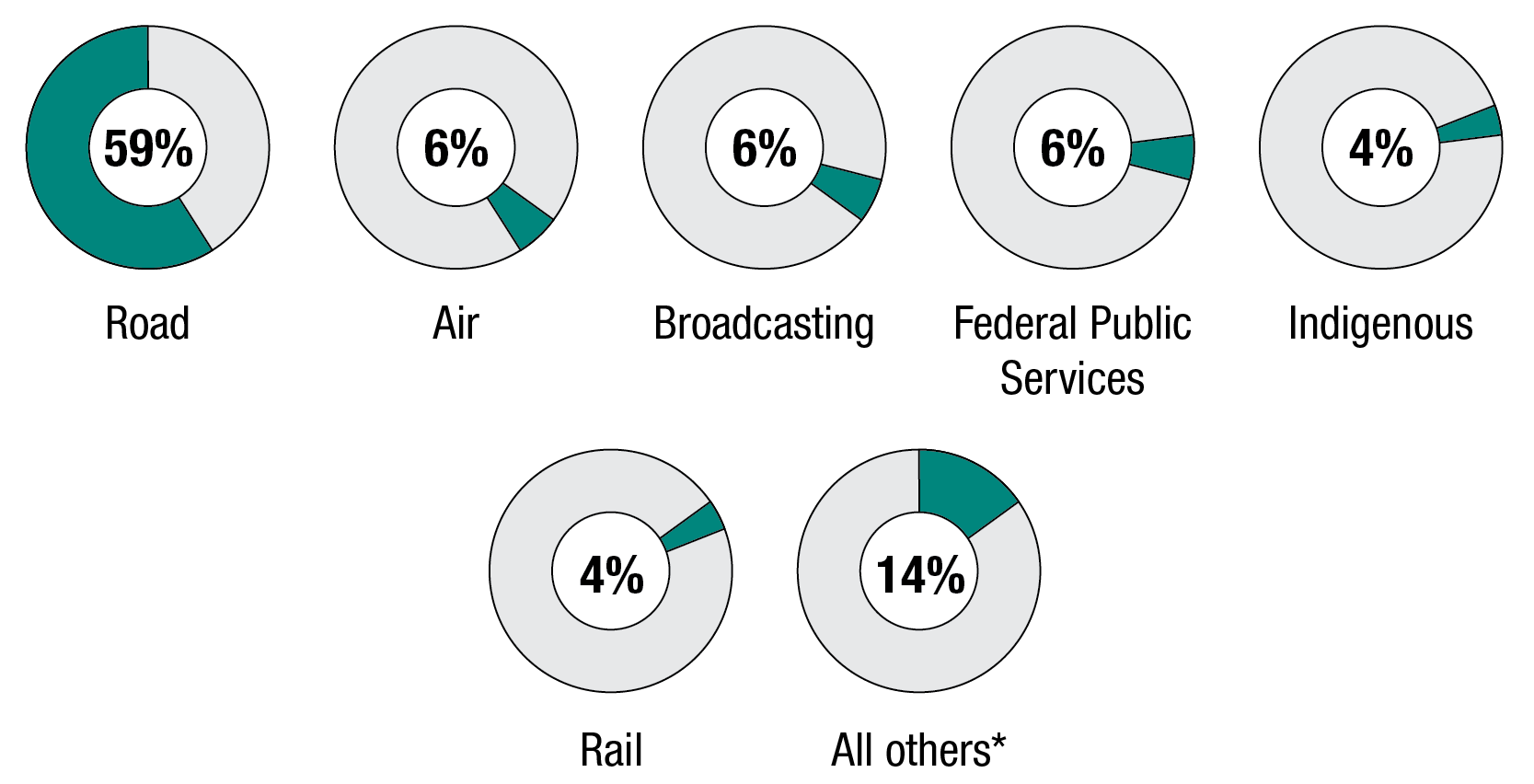
*All others include 2 fatalities each for the banking, feed, flour, and seed, longshoring and water transportation sectors. It also includes 1 fatality in each of the following 3 sectors:
- communications
- pipeline transportation, and
- grain handling/grain elevators
Text description of Chart 1.3
| Industry sector | Percentage of fatal work injuries |
|---|---|
| Road transportation | 59% |
| Air transportation | 6% |
| Broadcasting (television, radio, internet) | 6% |
| Federal public services/Public service departments/Crown corporations | 6% |
| Indigenous | 4% |
| Rail transportation | 4% |
| All Others* | 14% |
DIFR: In 2018, 6 of the 16 industry sectors under federal jurisdiction reported DIFRs higher than the national rate of 9.30 (See Chart 1.4). These industries were:
- postal services
- longshoring
- road transport
- air transport
- feed, flour and seed, and
- water transportation
The top 6 sectors in both 2017 and 2018 remained identical. Postal Services is the only sector to have reported a decrease from 2017 (41.39) to 2018 (37.82) (See Charts 3.1(a) and (b)).
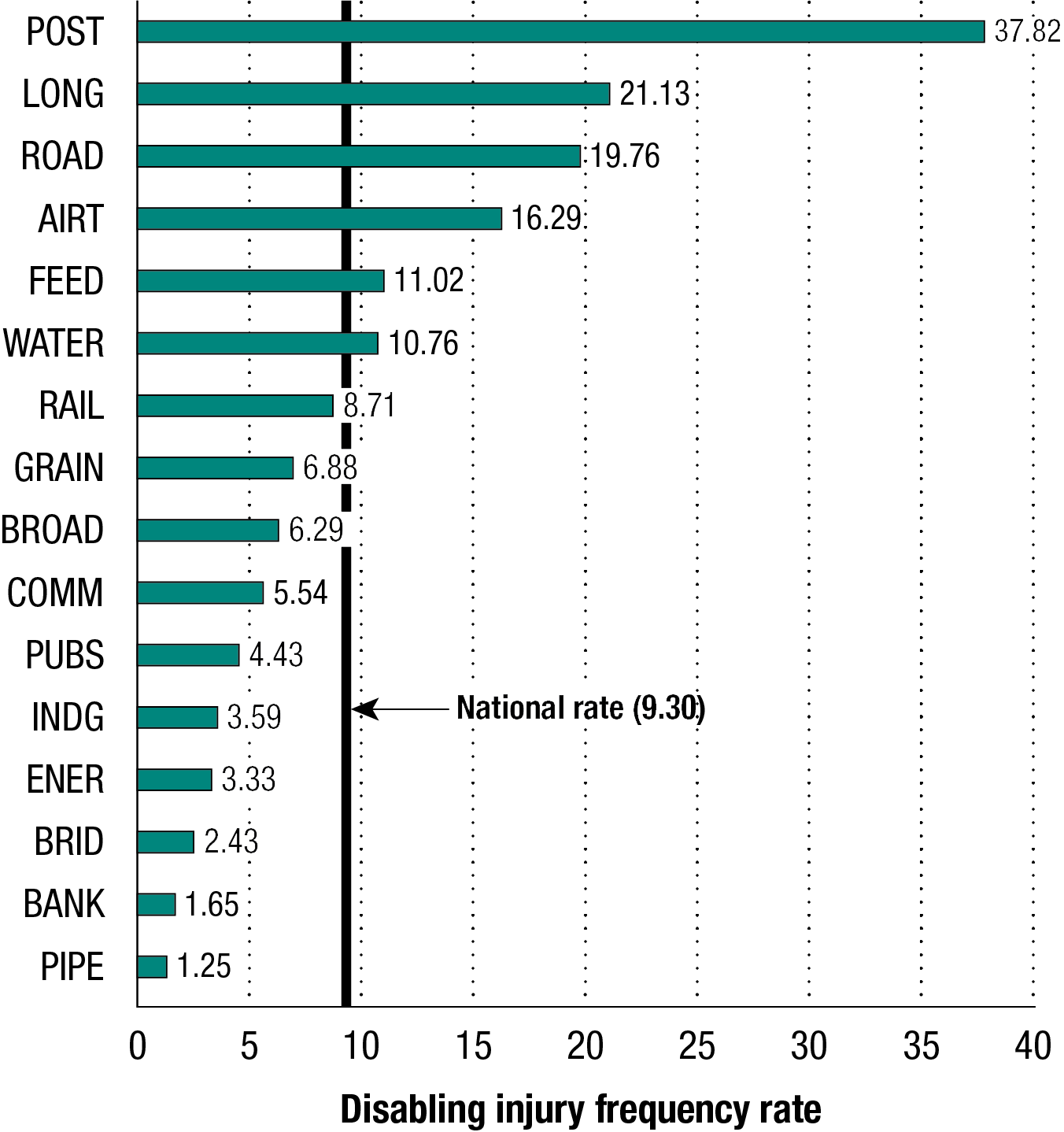
Text description of Chart 1.4
| Industry sector | Disabling injury frequency rate |
|---|---|
| Postal services/Postal contractors | 37.82 |
| Longshoring/Stevedoring/Port/Harbour operations/Pilotage | 21.13 |
| Road transportation | 19.76 |
| Air transportation | 16.29 |
| Feed, flour and seed | 11.02 |
| Water transportation (shipping and ferries) | 10.76 |
| Rail transportation | 8.71 |
| Grain handling/Grain elevators | 6.88 |
| Broadcasting (television, radio, internet) | 6.29 |
| Communications | 5.54 |
| Federal public services/Public service departments/Crown corporations | 4.43 |
| Indigenous | 3.59 |
| Energy/Mining /Mineral processing | 3.33 |
| Interprovincial infrastructure (bridges, tunnels, canals, causeways) | 2.43 |
| Banking/Banks | 1.65 |
| Pipeline transportation | 1.25 |
| National rate | 9.30 |
FIFR: Of the 16 industry sectors that fall within federal jurisdiction, 13 reported fatalities in 2018. Nine of these 13 industry sectors all reported FIFR values above the national rate (34.24):
- road transport
- longshoring/stevedoring/port/harbour operations/pilotage
- feed, flour, and seed
- broadcasting (television, radio, internet)
- pipeline transportation
- grain handling/grain elevators
- indigenous
- rail transport, and
- water transportation (shipping and ferries)
In comparison to 2017, the road transport, feed, flour, and seed, indigenous, grain handling, and broadcasting sectors were the 5 sectors above the national rate in both years. Along with these 5 sectors, the following industry sectors reported fatalities in 2017 and 2018:
- rail transportation
- air transportation
- federal public services/public service departments/crown corporations
- communications, and
- banking
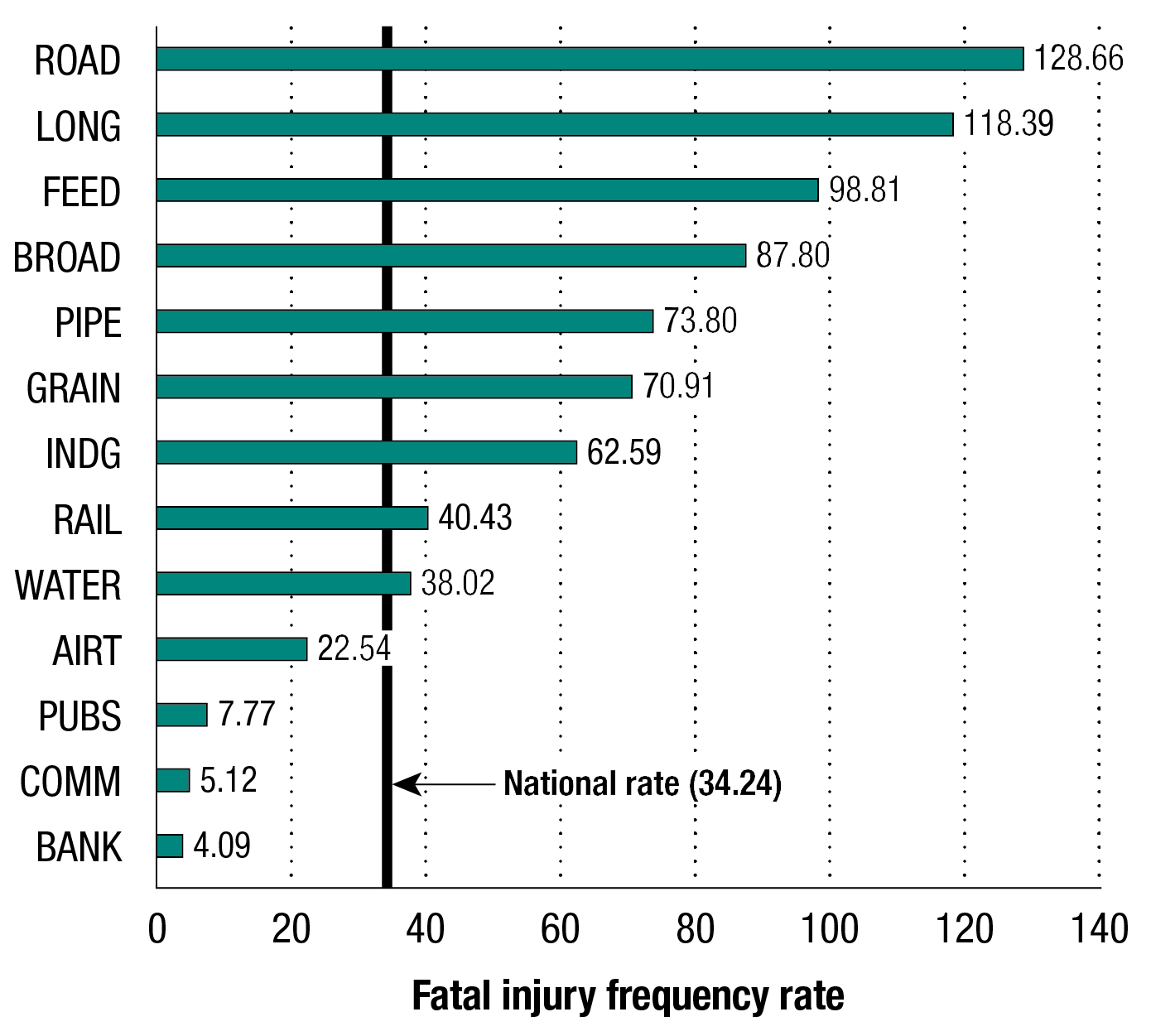
Text description of Chart 1.5
| Industry sector | Fatal injury frequency rate |
|---|---|
| Road transportation | 128.66 |
| Longshoring/Stevedoring/Port/Harbour operations/Pilotage | 118.39 |
| Feed, flour and seed | 98.81 |
| Broadcasting (television, radio, internet) | 87.80 |
| Pipeline transportation | 73.80 |
| Grain handling/Grain elevators | 70.91 |
| Indigenous | 62.59 |
| Rail transportation | 40.43 |
| Water transportation (shipping and ferries) | 38.02 |
| Air transportation | 22.54 |
| Federal public services/Public service departments/Crown corporations | 7.77 |
| Communications | 5.12 |
| Banking/Banks | 4.09 |
| National rate | 34.24 |
Occupational injuries for federal employers by province or territory, 2018
Disabling injuries: In 2018, 4 provinces (Ontario, Quebec, British Columbia and Alberta) accounted for 84% of all reported disabling injuries (see Chart 2.1). This can be attributed to these 4 provinces’ combined share (85%) of all reported federal jurisdiction employment (see Chart 2.2). There has been little change in the regional distribution of the total 2018 disabling injury numbers when compared to 2017.
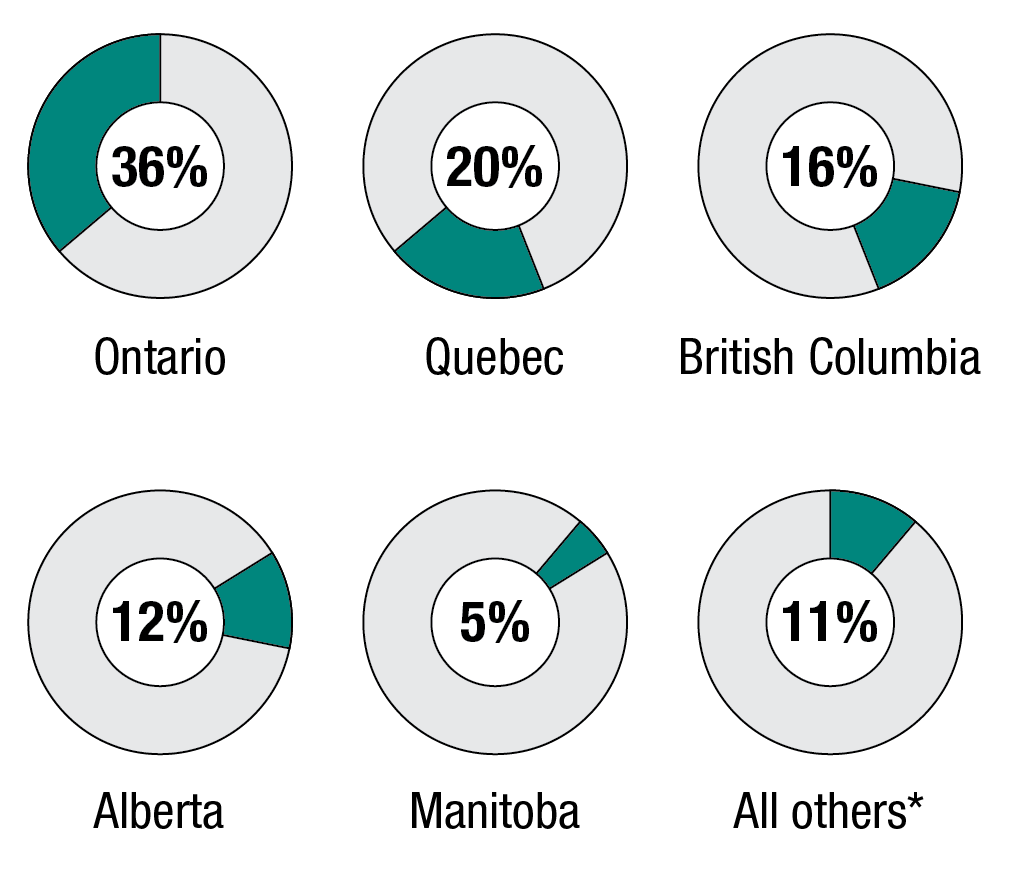
*All others:
- Nova Scotia: 3.3%
- Saskatchewan: 2.9%
- New Brunswick: 2.2%
- Newfoundland and Labrador: 1.3%
- Prince Edward Island: 0.5%
- Northwest Territories, Yukon, Nunavut 0.2% each
- Foreign: 0.1%
Text description of Chart 2.1
| Province/Territory | Percentage of disabling injuries |
|---|---|
| Ontario | 36% |
| Quebec | 20% |
| British Columbia | 16% |
| Alberta | 12% |
| Manitoba | 5% |
| All Others* | 11% |
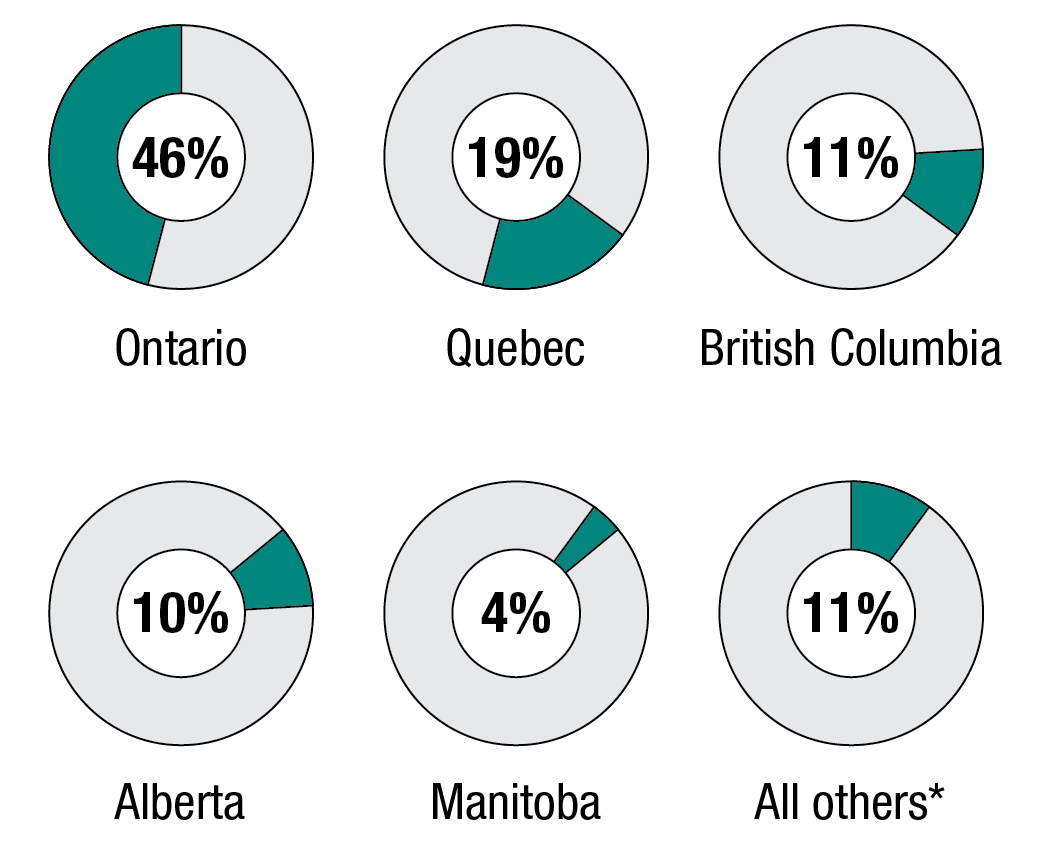
*All others:
- Saskatchewan: 2.9%
- Nova Scotia: 2.7%
- New Brunswick: 2.5%
- Newfoundland and Labrador: 1.3%
- Foreign: 0.6%
- Prince Edward Island: 0.5%
- Northwest Territories and Yukon 0.2% each
- Nunavut: 0.1%
Text description of Chart 2.2
| Province/Territory | Percentage of employees |
|---|---|
| Ontario | 46% |
| Quebec | 19% |
| British Columbia | 11% |
| Alberta | 10% |
| Manitoba | 4% |
| All others* | 11% |
Fatal injuries: In 2018, 5 provinces (Ontario, Alberta, British Columbia, Quebec and Saskatchewan) accounted for 86% of all reported fatal injuries (see Chart 2.3). Of these provinces, only Alberta’s share of fatal injuries increased from 11% in 2017 to 20% in 2018.
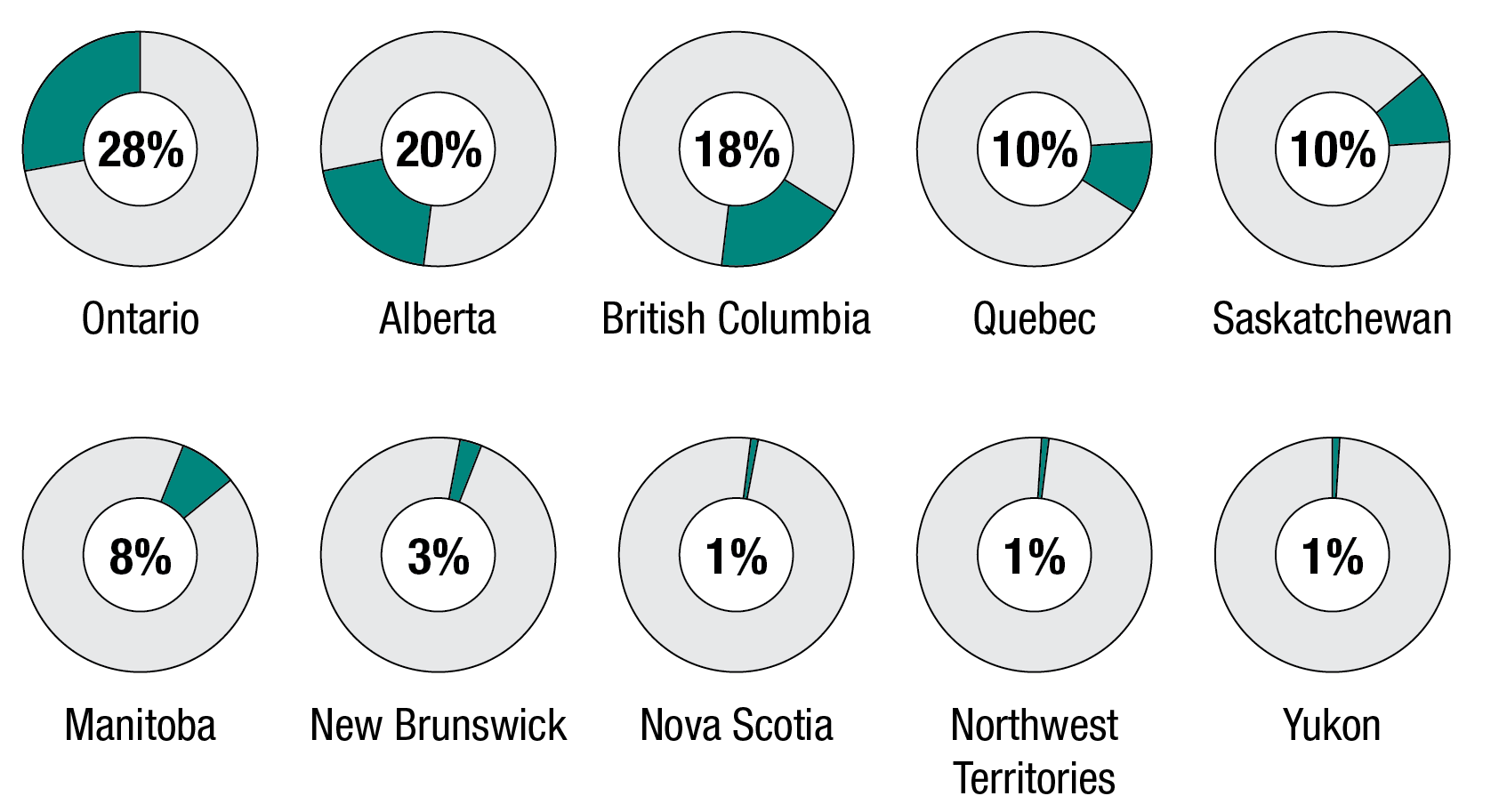
Text description of Chart 2.3
| Province/Territory | Percentage of fatal work injuries |
|---|---|
| Ontario | 28% |
| Alberta | 20% |
| British Columbia | 18% |
| Quebec | 10% |
| Saskatchewan | 10% |
| Manitoba | 8% |
| New Brunswick | 3% |
| Nova Scotia | 1% |
| Northwest Territories | 1% |
| Yukon | 1% |
DIFR: A total of 5 provinces and 2 territories reported DIFR values above the national rate of 9.30 (see Chart 2.4). Of these, Nunavut, Alberta, Nova Scotia, Quebec, and the Yukon reported a higher DIFR value in 2018 than in 2017. British Columbia, Manitoba, and Nunavut maintained the highest DIFR values in 2018 when compared to 2017.
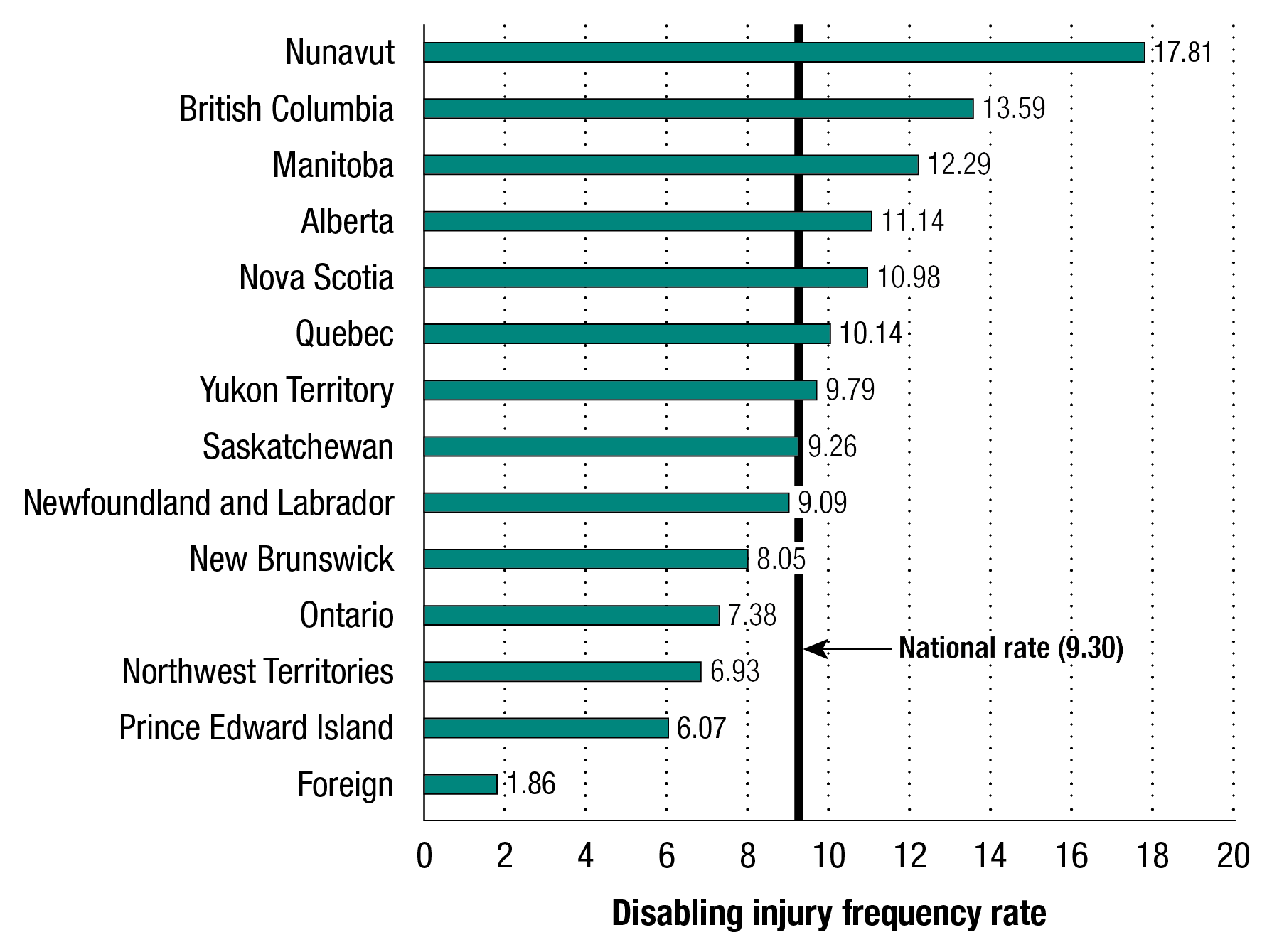
Text description of Chart 2.4
| Province/Territory | Disabling injury frequency rate |
|---|---|
| Nunavut | 17.81 |
| British Columbia | 13.59 |
| Manitoba | 12.29 |
| Alberta | 11.14 |
| Nova Scotia | 10.98 |
| Quebec | 10.14 |
| Yukon | 9.79 |
| Saskatchewan | 9.26 |
| Newfoundland and Labrador | 9.09 |
| New Brunswick | 8.05 |
| Ontario | 7.38 |
| Northwest Territories | 6.93 |
| Prince Edward Island | 6.07 |
| Foreign | 1.86 |
| National rate | 9.30 |
FIFR: Only Newfoundland and Labrador, Prince Edward Island and Nunavut reported no fatalities in 2018 (see Chart 2.5). In comparison to 2017, only Saskatchewan, Alberta, Manitoba and British Columbia remain above the national FIFR. They have also reported higher FIFR values in 2018 than in 2017. Of note, the FIFR for Yukon is significantly higher than all the other provinces and territories. This is because it reported one fatality for approximately 4.6 million hours worked. This resulted in an FIFR of 217.62 fatalities per one billion hours worked for Yukon in 2018 compared to the national rate of 34.24.
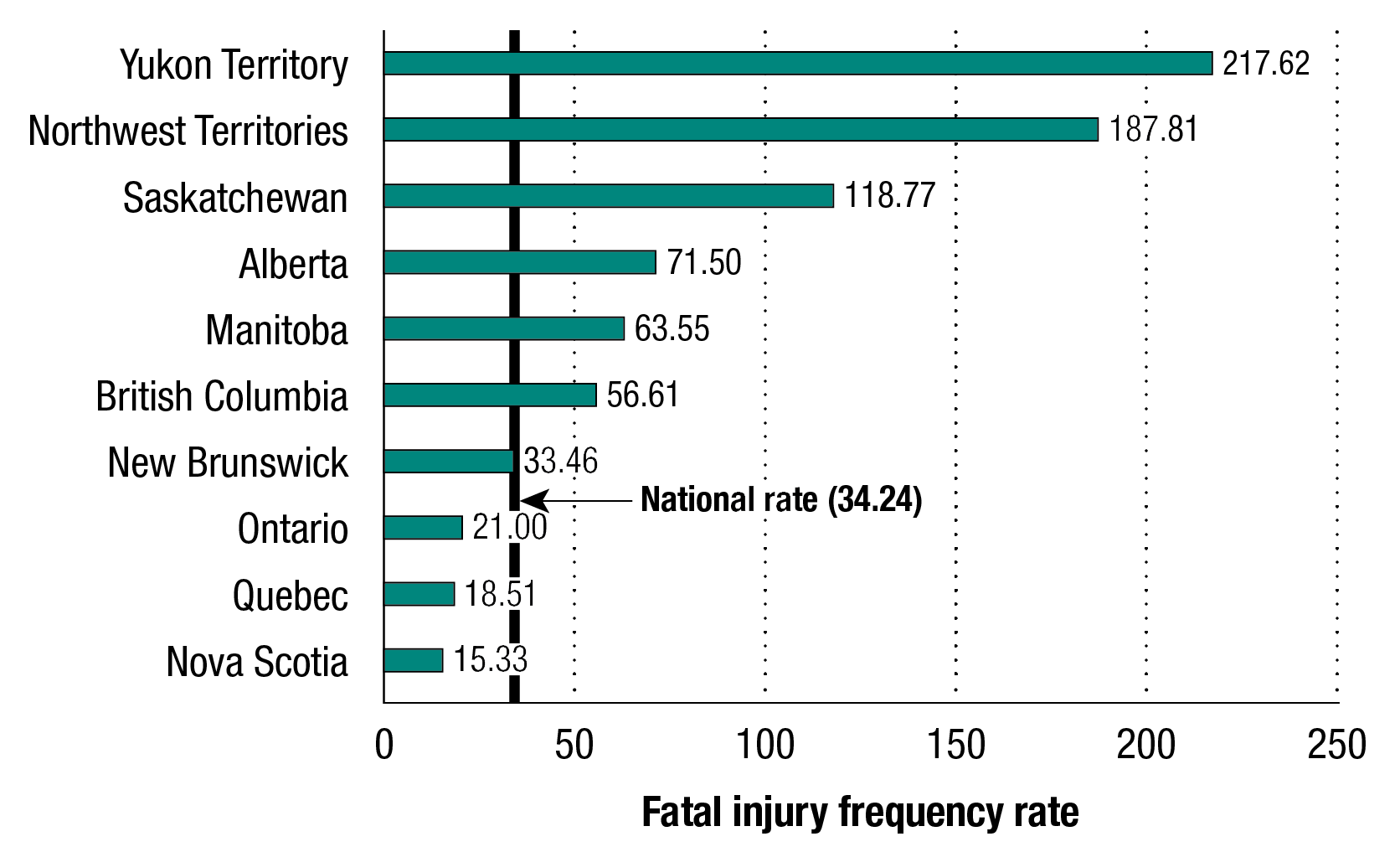
Text description of Chart 2.5
| Province/Territory | Fatal injury frequency rate |
|---|---|
| Yukon | 217.62 |
| Northwest Territories | 187.41 |
| Saskatchewan | 118.77 |
| Alberta | 71.50 |
| Manitoba | 63.55 |
| British Columbia | 56.61 |
| New Brunswick | 33.46 |
| Ontario | 21.00 |
| Quebec | 18.51 |
| Nova Scotia | 15.33 |
| National rate | 34.24 |
Glossary
The following definitions are for the purpose of this publication only.
Disabling injury
Any employment injury or occupational disease that:
- prevents an employee from reporting for work, or from effectively performing all the duties connected with the employee’s regular work, on any day subsequent to the day on which the occupational injury occurred, whether or not that subsequent day is a working day for that employee
- results in the loss by an employee of a body member or a part thereof, or in a complete loss of the usefulness of a body member or part thereof, or
- results in the permanent impairment of a bodily function of an employee
Disabling Injury Frequency Rate (DIFR)
Defined as the total number of disabling and fatal occupational injuries per one million hours worked. It is calculated based on the following formula: ((Total Disabling Injuries + Total Fatal Injuries)*1,000,000/Total Hours Worked).
Employee
Any person who has entered into or is employed under a contract of service or apprenticeship, written or oral, expressed or implied, whether by way of manual labour or otherwise. An employee is also any other person subject to the provisions of a workers’ compensation board act or any direction or order of a board.
Employment
- All work or activities performed in carrying out assignments or requests made by the employer. It includes related activities not specifically covered by an assignment or request
- Any voluntary work or activities undertaken while on duty for the benefit of the employer
- Any activities undertaken while on duty with the consent or approval of the employer
Fatal injury
An occupational injury or disease resulting in death.
Fatal Injury Frequency Rate (FIFR)
Defined as the total number of fatal occupational injuries per one billion hours worked. It is calculated based on the following formula: (Total Fatal Injuries*1,000,000,000/Total Hours Worked).
Federal jurisdiction
Federal jurisdiction covers:
- works, undertakings or businesses that are within the legislative authority of Parliament, and
- work declared to be for the general advantage of 2 or more provinces outside the exclusive authority of the provincial legislatures
Federal jurisdiction defined under the Canada Labour Code covers specific industries and their infrastructures. Consult the section industry sectors under federal jurisdiction for the list of industries.
Full-time Equivalent (FTE)
Refers to the employment of one person full time. It may also refer to more than one person part time whose total working time is the equivalent of one person working full time. FTEs are measured in person-years. For example:
- 100 people employed full time equals 100 FTEs
- 10 people employed half time equals 5 FTEs
- all 110 people combined represent 105 FTEs
Minor injury
An occupation injury or disease, excluding disabling injuries, for which treatment at a medical facility is provided.
Occupational injury
Any injury, disease or illness incurred by an employee in the performance of, or in connection with, his or her work.
Annex: Data charts
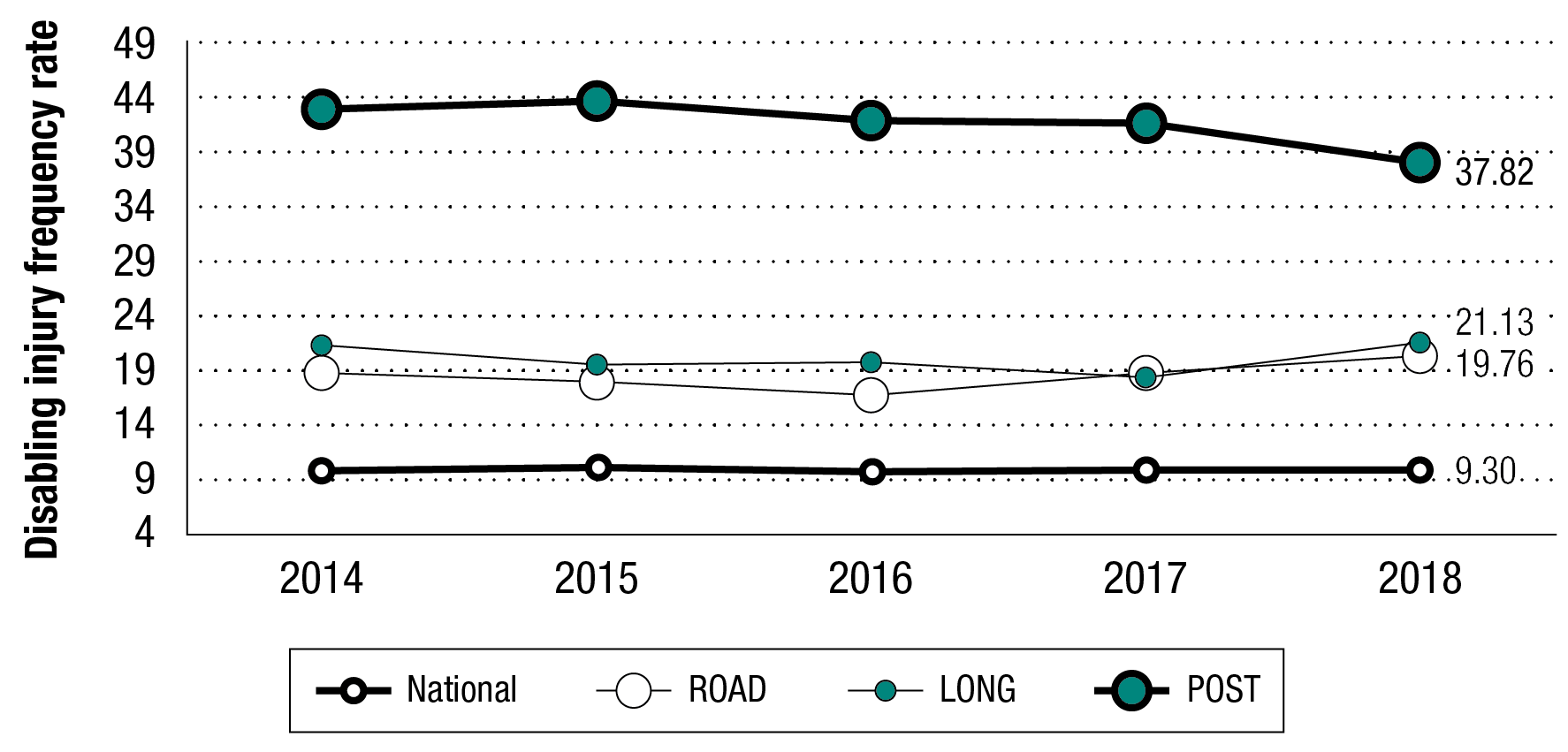
Text description of Chart 3.1 (a)
| Industry | 2014 | 2015 | 2016 | 2017 | 2018 |
|---|---|---|---|---|---|
| National rate | 9.25 | 9.42 | 9.13 | 9.17 | 9.30 |
| Road transportation | 18.38 | 17.59 | 16.26 | 18.32 | 19.76 |
| Longshoring/Stevedoring/Port/Harbour operations/Pilotage | 20.81 | 19.07 | 19.46 | 17.89 | 21.13 |
| Postal services/Postal contractors | 42.74 | 43.65 | 41.88 | 41.39 | 37.82 |
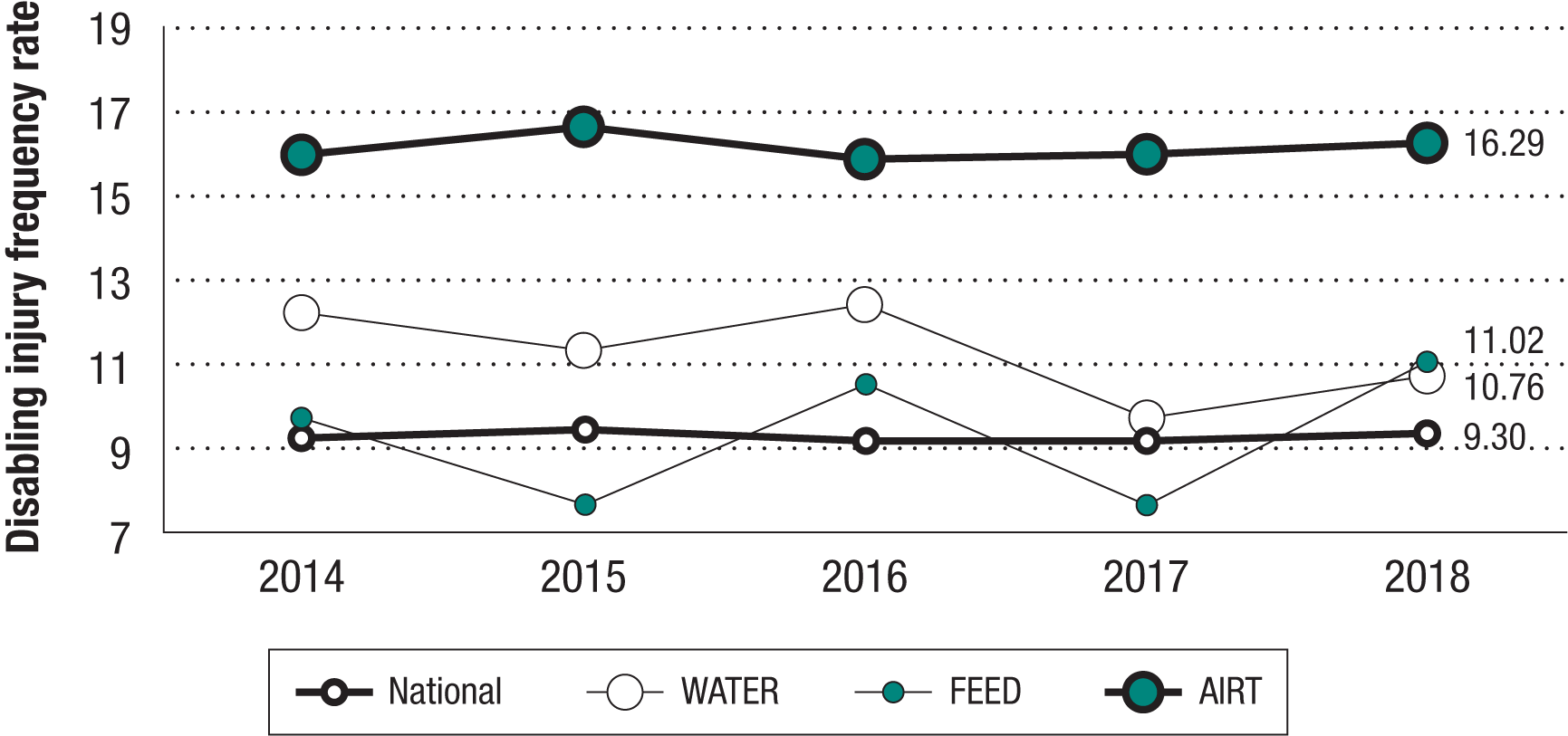
Text description of Chart 3.1 (b)
| Industry | 2014 | 2015 | 2016 | 2017 | 2018 |
|---|---|---|---|---|---|
| National rate | 9.25 | 9.42 | 9.13 | 9.17 | 9.30 |
| Water transportation (shipping and ferries) | 12.22 | 11.32 | 12.39 | 9.68 | 10.76 |
| Feed, flour and seed | 9.74 | 7.65 | 10.50 | 7.62 | 11.02 |
| Air transportation | 16.04 | 16.71 | 15.92 | 16.03 | 16.29 |
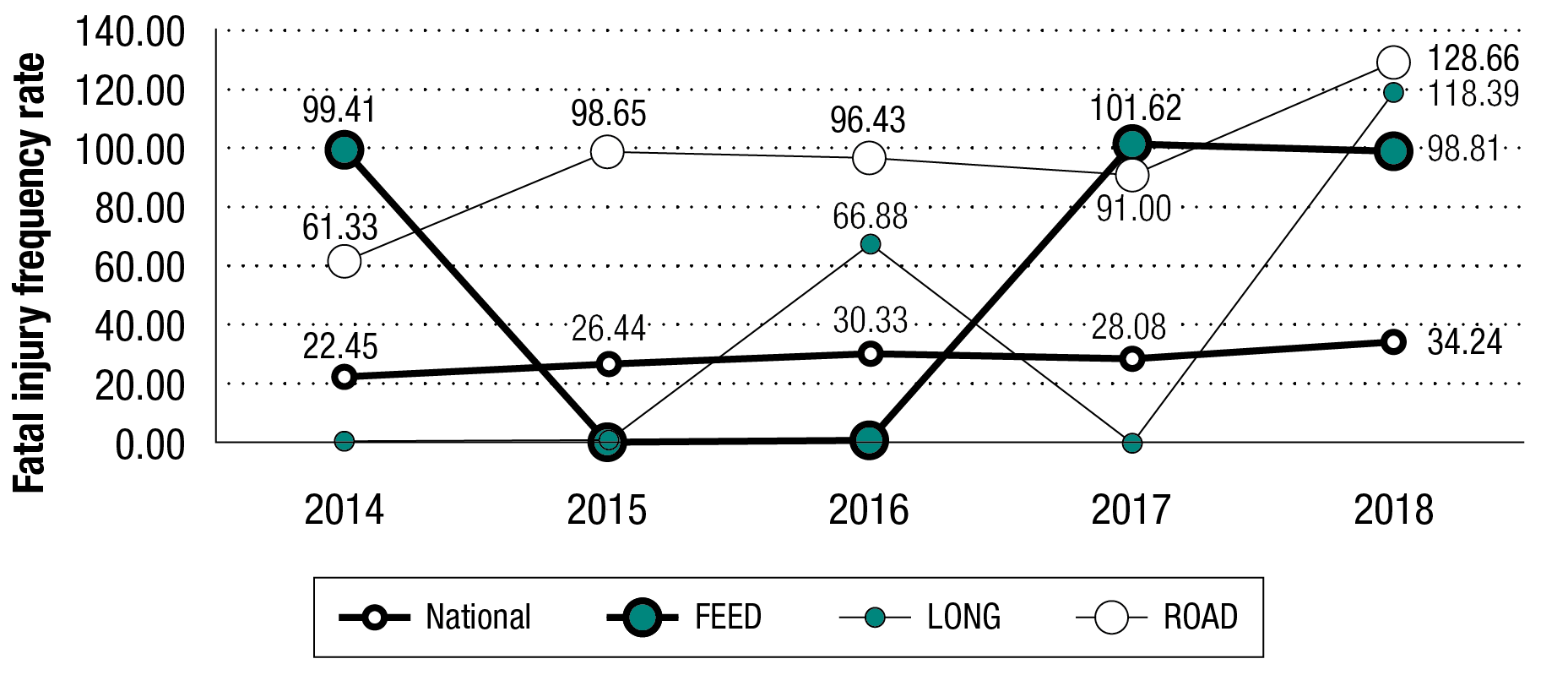
Text description of Chart 3.2
| Industry | 2014 | 2015 | 2016 | 2017 | 2018 |
|---|---|---|---|---|---|
| National rate | 22.45 | 26.44 | 30.33 | 28.08 | 34.24 |
| Feed, flour and seed | 99.41 | 0.00 | 0.00 | 101.62 | 98.81 |
| Longshoring/Stevedoring/Port/Harbour operations/Pilotage | 0.00 | 0.00 | 66.88 | 0.00 | 118.39 |
| Road transportation | 61.33 | 98.65 | 96.43 | 91.00 | 128.66 |
